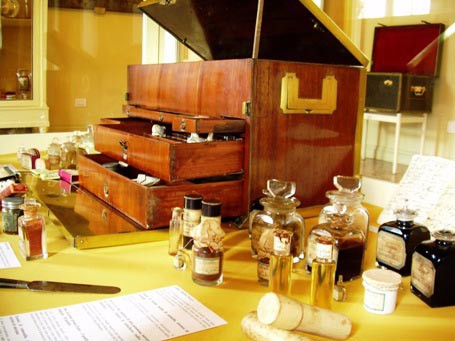Marie-Louise's travelling medicine chest is one of the most unusual objects in the Museo Glauco Lombardi collection. It was acquired in 1948 and notes from Glauco Lombardi himself give precious details concerning the provenance. The medicine chest was bought by Giuseppe Pandos at the sale of objects belonging to the ex-empress held in Parma in 1848 by her heir the archduke Leopold of Austria.
The chest then disappeared, not re-appearing until 1947 when it was sold by a certain Dr Parenti di Trecasali to a Parma antique dealer, from which Lombardi bought the piece for the not insignificant sum of 25,000 lira; in 1950 Lombardi bought from Pandos two further phials and a silver spoon (now missing) for 5,000 lira.
The chest was almost certainly made during Marie-Louise's French period, since the Bohemian crystal phials bear the monogram ML underneath an imperial crown. It was sent to Parma (along with many other objects) from Paris after the fateful March 1814. Marie-Louise however continued to use the medicine chest, and she had a brass plaque bearing her ducal arms set in the lid.
The chest contained everything Marie-Louise required for her medical well-being when travelling. It comprises different compartments and nests of drawers containing a complete assortment of medicines, vegetal extracts, homeopathic remedies, pharmaceutical preparations all in crystal phials of varying dimensions, each bearing a label indicating the contents. Quite remarkably many of these contents are still present, in varying quantities. Also included in the medicine chest are glass and porcelain pots, card boxes, a spatula, straws made of blown glass, recipients for blood samples, bandages, cotton and two manuscript inventories, one of which initialled by the famous Italian doctor Lorenzo Berzieri, who discovered the therapeutic qualities of the spa waters at Salsomaggiore (Emilia Romagna).
Of particular interest is the appearance of the ‘gentle' medecines, such as oil, camomile, valerian, mint, rhubarb, aloes, etc. (still used today in modern homeopathy and herbology), alongside highly poisonous substances such as aconite, lead acetate, ipecacuana, extract of sebina, scilla maritima, belladonna, etc., poisons, opiates, hallucinogens, pain killers, or poison antidotes such as the famous teriaca or Venetian treacle.
The medicine chest is therefore completely modern for the period in which it was made and shows that Marie-Louise not only took local cures but also medicines used further abroad in Europe.
Marie-Louise travelled frequently and her chest was clearly indispensable. The fact is, the Duchess was frequently ill, as her correspondence shows, varying from respiratory difficulties, colds, rheumatism and headaches. Indeed, the latter became so bad that she was trepanned in May 1839 with small pieces of bones being removed from her skull, pieces today held at the Museo Lombardi.
Francesca Sandrini (tr. P.H.)
Director of the Museo Glauco Lombardi, Parma
May 2007
Marie-Louise’s travelling medicine chest

- Date :
- French (1810-1814)
- Technique :
- Box: walnut, brass
- Dimensions :
- H = 30 cm, L = 55.9 cm, P = 28.4 cm
- Place held :
- Museo Glauco Lombardi, Parma
- Photo credit :
- Museo Glauco Lombardi, Parma

